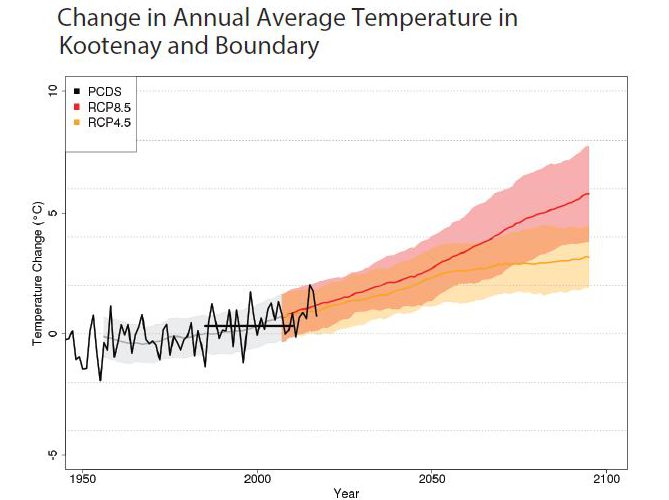The BC Agriculture and Food Climate Action Initiative workshops kicked off in Creston this week and saw a lot of information gathered between local agricultural producers.
The event was organized by Harmony Bjarnason and the Climate Change Action Initiative.
Participants in the workshop were partitioned into four groups and lead by a facilitator. Groups learned and discussed the statistics and predictions based off data collected by the Pacific Climate Impacts Consortium. After, they brainstormed ideas to help combat the effects of extreme flooding, drier summers and irregular weather patterns just to name a few.
When asked to rate the most dire effects of climate change, water and its management was at the top of the list for each of the four tables.

For an individual effort, Bjarnason said farmers will have to learn water saving measures to prepare for drier summers.
“Looking at the water availability and how that availability will be affected by climate change and really planning for those conditions, maybe currently you have enough water to do all the things you need to do on your farm. But in 20 years time, you’re looking at much drier summers and you’re going to need to use some new practices.”
By 2050 precipitation may drop by 33% on a bad year with an average of 12% less rainfall.

* Growing Degree-Days (GDD) are a measure of heat accumulation, and represent the cumulative number of degrees that the average daily temperature is above a base temperature of 5°C, for all days of the year.
* Icing Days (ID) represent the number of days the maximum 24 hour temperature remains below freezing.
* Growing Season Length (GSL) represent the number of days between the first span of six consecutive days with a daily mean temperature above 6°C and the last day with a daily mean temperature above 6°C.
Earlier and hotter springs will also increase the chance of flooding meaning there will be a dangerous amount of water at inopportune times. Dyking districts were brought up during the workshop as well as reservoirs that could be able to collect floodwater for later use during the dry summer months. This is all in theory however, and massive infrastructure projects like this would have to be funded by the government if water levels rise to emergency levels on a regular basis. Some farmers are worried about the risk of loosing farmland if preventative measures aren’t made sooner rather than later.
Wildfires and the smoke it causes was another hot topic on the table. According provincial statistics, in 2017 over 1.2 million hectares of land was burned and total cost of fire suppression cost over $568 million. The amount of people displaced was roughly 65,000. 2018 was no better. Workshop participants talked about mapping out combustibles on their land and having an evacuation plan. The FireSmart meeting hosted in Creston was brought to light and inadvertently planned same week as the climate change workshop.
It’s not just the flames that producers need to prepare for. Having experienced multiple summers in a row where smoke impacted yields, local farmers are beginning to rethink what they grow.
“Smoke really affected everyone.” Harmony said after discussing the effects with participants. “Berry producers, their crops weren’t ripening. Grapes, the sugar content was low this year because of the heat dampening effect of smoke. In poultry when the meat birds were sent off to market, their weight was down significantly.”
She says farmers were sometimes able to recover if smoke hit early in the season and brainstormed the idea of planting crops which require less growing degree days and heat units.

Many more climate change factors that have agricultural impacts were discussed and teams were given the task to measure the assets producers currently have and what sort of gaps need addressing.
Organizations such as Fields Forward, the Columbia Basin Trust and local regional district authorities were considered assets. But as Creston town councilor pointed out, many of these organizations work in silos which means more collaboration will be necessary for future projects.
Major gaps brought to light are the slow decision making processes made by the Provincial Agricultural Land Commission and lack of infrastructure in remote areas. Participants said they desire better internet service to stay connected and informed as well as a more accurate monitorization of local weather patterns including air quality.
All of the information, from concerns to solutions, will be gathered by the The Kootenay Boundary Regional Adaptation Workshops and prepared for a second set of workshops in late January.
Participants will then focus on solutions for a more consolidated list of climate change factors. The budget for the project is $300,000.00. It will help farmers help themselves but not fund massive infrastructure projects .
Jeff Lee, owner of Swan Valley Honey said the immediate benefit from the workshop was the sharing of knowledge between producers.
“I think one of the things that really helps here is the transfer of knowledge from the various farmers, the various regional district directors and the various commodity folks here. To understand what we face in the future. What comes out of that then is the opportunity to look at what we may be able to do and what we may not be able to do.”
In one example, Lee told participants in the workshop to avoid completely clearing wild land and brush near crops as that is where pollinators thrive.
Lee noted that the competitive nature farmers may have in some communities and certain secrets of the trade might hold value today. However, he says combating the effects of climate change is another story. To put it in his words,
“Either we all collectively win, or we all collectively lose.”


